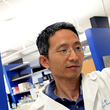
Eric Chang Lab
We focus on signal transduction cross-talks between RAS GTPases and the estrogen receptor in the control of breast tumor growth, treatment resistance, and metastasis. Our studies are guided by clinical data telling us what problems the patients are facing, as well as vulnerabilities in the tumors that can be exploited in the lab. Our ultimate goal is to discover personalized treatment strategy that can be later used in the clinic.

Chonghui Cheng Lab
The Cheng lab strives to understand the fundamental questions of how RNA regulation controls cellular processes in normal biology and in the context of cancer. Working at the interface of RNA splicing and breast cancer biology, our current focus is on regulation of breast cancer metastasis driven by alternative splicing.

Gloria Echeverria Lab
The Gloria Echeverria Lab tackles the molecular evolution of triple negative breast cancer therapy resistance and metastasis.

Suzanne Fuqua Lab
Research in the Fuqua Lab was paramount in discovering the clinical significance in breast cancer progression and resistance to hormonal therapies in estrogen receptor-positive breast cancer. The lab focuses on both basic laboratory investigation and translational breast cancer research. Recently mutations in ER have been rediscovered by a number of laboratories validating her earlier seminal work. The Y537N mutation is a constitutionally active receptor that was first discovered in metastatic breast tumors by Dr. Fuqua.

The Hilsenbeck Lab focuses on biostatistics and informatics collaborating on cancer-related biomedical research. The lab has considerable experience with clinical trials, prognostic and predictive factors, as well as analysis of expression array and proteomic (RPPA) data.

Michael Lewis Lab
The Lewis Lab studies normal mammary gland development and breast cancer primarily using mouse genetic models and human xenografts. The current focus is on the role of hedgehog signaling and homeobox genes in normal development, and on the characterization of breast cancer stem cells, particularly with respect to treatment resistance.

Yi Li Lab
The Li laboratory studies the molecular and cellular mechanisms of breast cancer initiation and evolution. This lab pioneered the use of the RCAS-TVA avian retroviral system to introduce cancer-driving mutations into just a few cells in the midst of normal cells in the mouse mammary gland, thus more closely mimicking human breast cancer formation where only one or a few cells mutate to initiate the cancer development. The lab uses this unique method along with genetically engineered mouse models as well as human cell lines and patient tissue samples to investigate the fundamental questions in breast cancer progression and cancer stem cells. This group also studies the impact of pregnancy, diabetes, and antipsychotic drugs on breast cancer, and explores new approaches to breast cancer prevention.

Schiff - Osborne Lab
The laboratory of Dr. Schiff and Dr. Osborne studies key oncogenic signaling pathways for targeted therapy in breast cancer and the mechanisms of drug resistance. The lab's goal is to design and translate to the clinic, strategies that better predict, prevent, or overcome resistance by using tailored drug combinations with a favorable safety profile.

Xiang Zhang Lab
The Zhang Lab investigates biological mechanisms and therapeutic strategies of breast cancer metastasis. The lab is currently investigating early-stage bone colonization of disseminated breast cancer cells and breast cancer-induced immunosuppression.

Bing Zhang Lab
Bing Zhang Lab develops and uses integrative bioinformatics approaches to extract biological meanings from experimental data and generate hypotheses for experimental validation.








